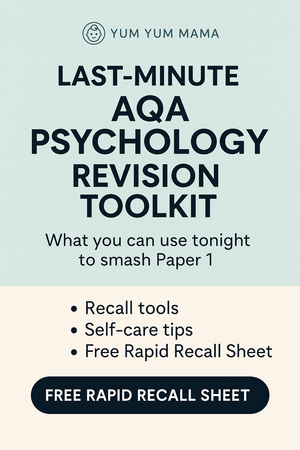Phonological Loop Working Memory
The phonological loop is a critical component of the Working Memory Model (WMM) proposed by Baddeley and Hitch (1974). It is specialised for processing and storing auditory information and is essential for understanding spoken and written language, verbal problem-solving, and retaining information in short-term memory. This article will provide an in-depth exploration of the phonological loop, its function, and its significance, tailored for AQA A-Level Psychology students preparing for exams.
What Is the Phonological Loop?
The phonological loop is one of the "slave systems" within the Working Memory Model. It is responsible for processing verbal and auditory information and consists of two key components:
-
Phonological Store (Inner Ear): Temporarily holds auditory information, such as words or sounds, for about 1-2 seconds.
-
Articulatory Control Process (Inner Voice): Rehearses and refreshes the information in the phonological store through subvocal repetition, enabling us to keep it active in short-term memory.
For example, when you try to remember a phone number by repeating it to yourself, you are utilising your phonological loop.
Key Features of the Phonological Loop
-
Limited Capacity: The phonological loop can hold information that can be articulated in about 2 seconds.
-
Encoding Format: It processes information acoustically (in sound form).
-
Rehearsal Dependency: Without rehearsal, information in the phonological loop decays rapidly.
Functions of the Phonological Loop
-
Language Development: Essential for acquiring and understanding language.
-
Verbal Problem-Solving: Helps retain instructions and solve verbal tasks.
-
Learning: Plays a critical role in tasks requiring memorisation, such as learning new vocabulary or solving maths problems.
Examples of the Phonological Loop in Action
-
Everyday Example: Remembering someone’s phone number long enough to type it into your phone.
-
Research Example: Baddeley et al. (1975) demonstrated the word length effect, showing that shorter words are easier to remember because they can be articulated within the phonological loop’s 2-second capacity.
Advantages and Disadvantages of the Phonological Loop
Advantages:
-
Supported by Empirical Evidence: Studies like Baddeley et al. (1975) and neuroimaging research validate its role in processing auditory information.
-
Practical Applications: Understanding phonological deficits can inform treatments for dyslexia and speech disorders.
Disadvantages:
-
Reductionist: Focuses only on verbal and auditory information, ignoring other types of memory processing.
-
Limited Understanding of Capacity: Its capacity is often described as vague and reliant on rehearsal.
Comparison with Other WMM Components
-
Visuo-Spatial Sketchpad: Processes visual and spatial information, unlike the phonological loop, which handles verbal data.
-
Central Executive: Supervises and allocates tasks to the phonological loop and visuo-spatial sketchpad.
-
Episodic Buffer: Integrates information from multiple sources, linking the phonological loop and other components to long-term memory.
AQA A-Level Exam Questions
1. Describe and Evaluate the Working Memory Model (8 Marks)
AO1 (4 Marks):
The Working Memory Model (WMM) was proposed by Baddeley and Hitch (1974) as an explanation of short-term memory. It consists of four main components: the central executive, which oversees the system and allocates resources; the phonological loop, which processes verbal information; the visuo-spatial sketchpad, which processes visual and spatial data; and the episodic buffer, which integrates information and links it to long-term memory. The phonological loop is subdivided into the phonological store and the articulatory control process.
AO3 (4 Marks):
Strength: The WMM is supported by evidence from dual-task studies, which show that people can perform a visual task and a verbal task simultaneously, but struggle with two tasks that require the same component (Baddeley, 1975). This suggests separate systems for visual and verbal information.
Limitation: The central executive is criticised for being vague and poorly defined. For example, it is unclear how it operates or allocates resources, making it difficult to test experimentally.
2. Discuss the Working Memory Model (16 Marks)
AO1 (6 Marks):
-
Description of WMM, including central executive, phonological loop, visuo-spatial sketchpad, and episodic buffer.
-
Details of the phonological loop: phonological store and articulatory control process.
-
Evidence: Baddeley et al. (1975) and dual-task studies.
AO2 (4 Marks):
Rory’s ability to talk to his grandparent while playing a game demonstrates the central executive’s ability to divide attention between different subsystems. When asked to describe his route to school, Rory puts the game down because both tasks require the visuo-spatial sketchpad, exceeding its capacity.
AO3 (6 Marks):
One strength of the WMM is its empirical support from dual-task studies (Point). This is because studies like Baddeley et al. (1975) show that participants perform better when tasks use different components, such as the phonological loop and visuo-spatial sketchpad, compared to tasks using the same component (Because). This supports the WMM’s claim that short-term memory is not unitary but consists of multiple components (Why). However, dual-task studies are often conducted in highly controlled laboratory conditions, which may lack ecological validity (Counterargument).
A limitation of the WMM is that the central executive is vague and poorly understood (Point). This is because there is little direct evidence about how it functions or allocates attention (Because). This reduces the model’s explanatory power and makes it difficult to design experiments to test the central executive (Why). However, neuroimaging studies, such as those using fMRI, have provided indirect support by identifying brain areas associated with attentional control, lending some credibility to the concept of the central executive (Counterargument).
3. Describe the Phonological Loop Component of the Working Memory Model (3 Marks)
AO1 (3 Marks):
The phonological loop is a component of the WMM responsible for processing auditory and verbal information. It consists of the phonological store, which holds sound-based information for about 1-2 seconds, and the articulatory control process, which rehearses the information to keep it active. Its capacity is limited to what can be articulated in 2 seconds.
4. Outline and Evaluate the Central Executive as Part of the Working Memory Model (4 Marks)
AO1 (2 Marks):
The central executive is the supervisory system within the WMM. It has a limited capacity and is responsible for directing attention and allocating tasks to the phonological loop, visuo-spatial sketchpad, or episodic buffer. It also integrates information from these components.
AO3 (2 Marks):
Strength: The central executive is supported by evidence from dual-task studies, which show that individuals can perform two tasks simultaneously if they involve different subsystems.
Limitation: However, it is criticised for being vague and poorly defined, as there is little direct evidence about its exact function.



